DFI LANParty UT nF3-250Gb: Overclocker's Dream
by Wesley Fink on September 8, 2004 12:05 AM EST- Posted in
- Motherboards
BIOS: DFI LANParty UT nF3 250Gb

The DFI uses the familiar Award BIOS, so navigation will be familiar for most users. DFI has championed the CMOS Reloaded feature on recent boards, particularly those aimed at overclockers. However, CMOS Reloaded is not a feature of the LANParty UT.
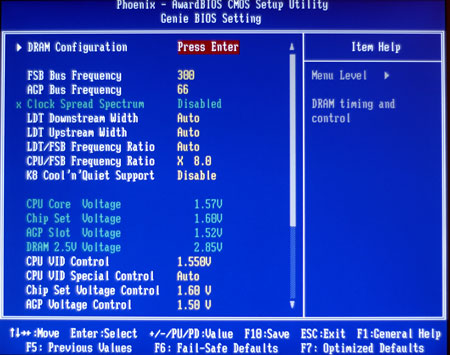
Most of the options of interest to overclockers are contained in the Genie BIOS Menu. This includes FSB, AGP, HT ratios, CPU ratios, voltages, Cool'n'Quiet, and DRAM timings.
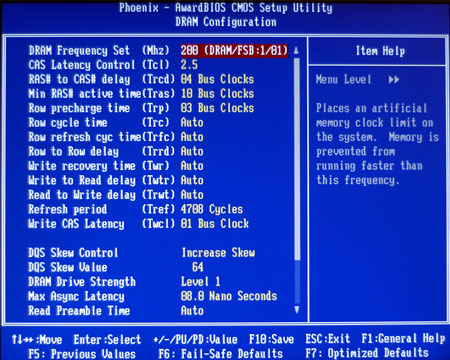
One look at the Dram timing options will leave no doubt as to the target market for this DFI. Every common timing option has a wider range of values than normally seen. The familiar CAS options, for example, include the common 2.0, 2.5, and 3.0 settings, but you can also choose CAS 1.5 or 3.5 or 4.0 or 4.5. There are also a complete package of DQS skew, drive strength, and latency selections to satisfy even the fussiest memory tweakers.
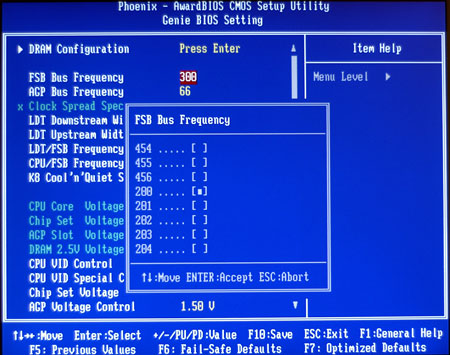
FSB can now be adjusted over the incredibly wide range of 200 to 456 in the BIOS. This should be a range that provides all that any overclocker, even those with phase-change or water cooling, will need to get the most from their Athlon 64 and memory.
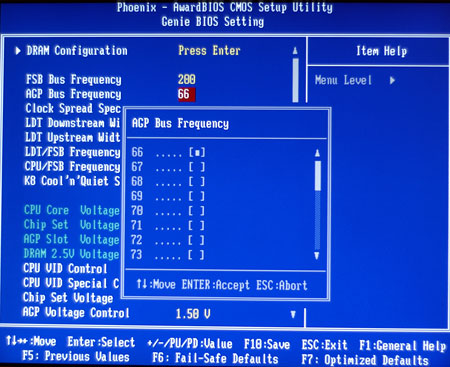
AGP can be fixed at any frequency from 66 to 100, but most users will probably leave it at 66.

The LANParty UT uses the nF3-250Gb chipset, and offers HyperTransport adjustments to 5X (1000 HT). This is a much wider and more useful range than what we saw on earlier boards for Athlon 64. DFI also provides some useful half multipliers at the lower ratios. The 0.5X adjustments are very useful for getting the best performance in overclocking.
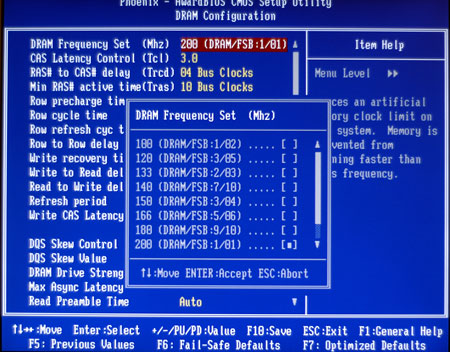
DFI provides a very wide range of memory speeds to allow tweaking in order to get the most from whatever memory that you have. It is rare to see such a broad range of memory ratios available, with the ability to choose 1:2, 3:5, 2:3, 7:10, 3:4, 5:6, 9:10, and 1:1.
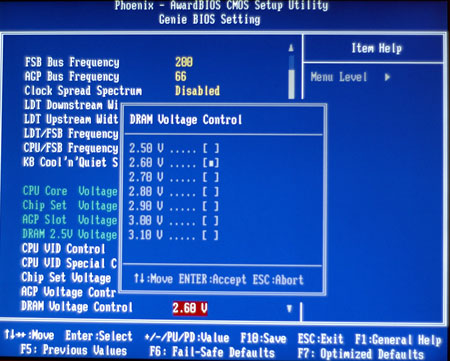
Memory Voltage can be adjusted to 3.1V, which is a truly useful range for almost any memory that you can buy. DFI tells us that they will likely add 2 more choices to 3.3V in an upcoming BIOS. This will even cover extreme overclocking of the OCZ EB memory, which has been reported to reach near 300FSB at 3.2V in this DFI board.

The other part of high FSB clocking is CPU ratios or multipliers. The DFI provides the kind of fine control that overclockers want with a full range from 4.0 to 20.0 in 0.5X increments. Keep in mind that while all Athlon 64 chips can be downclocked with lower ratios, only the FX chips are completely unlocked. We confirmed that the lower ratios do work as they should on the DFI. You can also select higher multipliers than your CPU specification, but the boot will be at the CPU's rated ratio on boot.
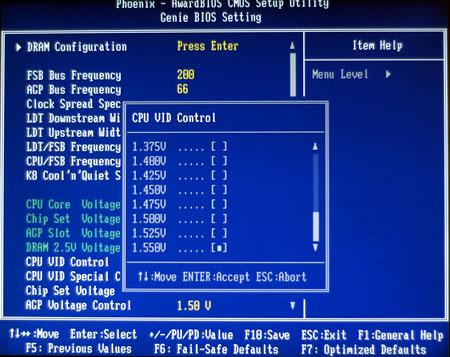
DFI uses two different controls for setting CPU voltage. The regular vCore range extends from 0.8V to 1.55V, which is a modest voltage top for a chip rated at 1.50V.
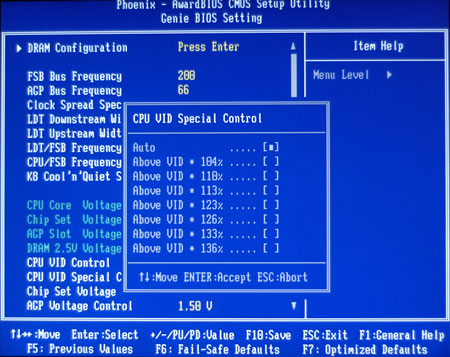
However, the real CPU voltage control is under another option called "Vid Special". Here, you can adjust the selected voltage by percentage from 4% to 36%. This means that with a base voltage of 1.55V and a Vid Special of 36%, you have selected a CPU voltage of 2.11V. This is a very wide and useful range, but it does require caution if you are air cooling. AMD does not recommend voltages higher than 1.7V for air cooling. Serious overclockers will find this additional headroom very useful in more extreme overclocking setups.

AGP voltage adjustment covers a broad range to 1.8V. This adjustment usually makes very little difference in overclocking.
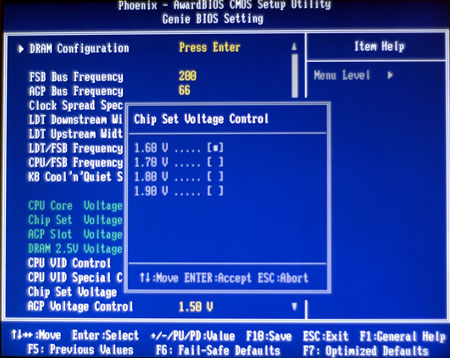
The DFI LANParty UT also provides for chipset voltage adjustments from 1.6V to 1.9V. This is very useful when trying to reach extreme overclocks on the nF3-250Gb chipset.
All of these settings are in the Genie BIOS Menu, but there are many other options in the DFI BIOS.
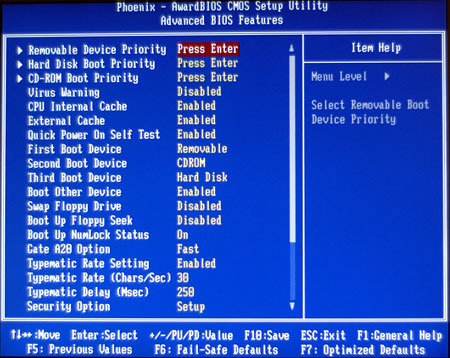
Advanced BIOS features allow control of boot devices and boot order.
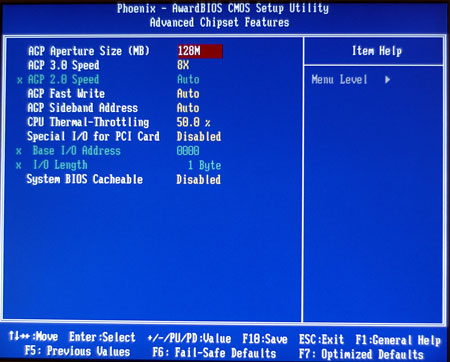
With so many of the most used adjustments in Genie BIOS, the Advanced Chipset menu is mainly AGP aperture size, timings, and shadowing control.
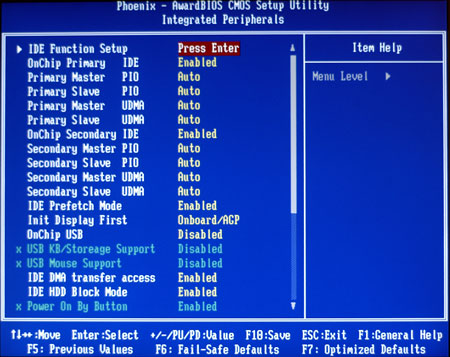
The nF3-250Gb supports many integrated features. Most of these are controlled in the Integrated Peripherals menu. This includes an IDE Function Setup sub-menu where setup and adjustments are made to the nVidia RAID for SATA and IDE drives.
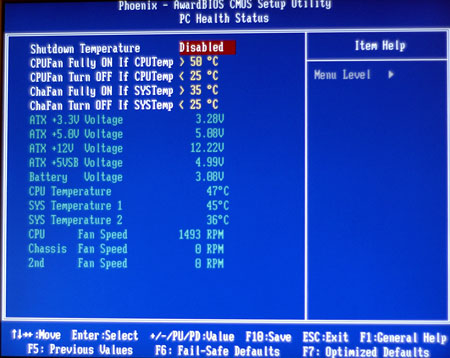
BIOS monitoring of Temperatures and Fan Speeds can be adjusted in the PC Health Status Menu.










54 Comments
View All Comments
ciwell - Wednesday, September 8, 2004 - link
"Overclocking for Dummies"I like the sound of that! :D
punko - Wednesday, September 8, 2004 - link
Impressive Article !Can't wait for the first edition of Anantech's "Overclocking for Dummies"
as the whole concept of FSB and memory tweaking both interests and scares me.
Now if only I could justify to the wife retiring my current rig . . .
gimper48 - Wednesday, September 8, 2004 - link
So when is the next overclockers guide? Can we expect to see this board in it?Wesley Fink - Wednesday, September 8, 2004 - link
#1 - The Asus K8N-E will be included in a roundup of new 754 boards in the next week.#2,#4 - Corrections made
#7 - The final correct name of the series is LANParty UT, as you point out. The name has been corrected in the article. DFI considered many last minute changes - from full LANParty to bargain board. Final decisions were quite recent.
#9 - We received this production board by Express shipment direct from Taiwan on September 1, after several delays. We are told by DFI that this is the production board. DFI, like other manufacturers, will likely make further improvements during the production run.
mikedustin - Wednesday, September 8, 2004 - link
I've been waiting for this board for a long time, only one problem I have with it, why did they pick yellow? I was wanting UV green. :(Oh well, I hope it will match my green case anyway.
DFI is on the right track as a mobo maker, this board is just another big win for them.
tomati - Wednesday, September 8, 2004 - link
I have read in other forum that DFI have postpose the 2 september to the 9 because of last change in the design board , so can I expect the same result as yours ?(you told about the pre version , right?)
tomati - Wednesday, September 8, 2004 - link
geoff2k - Wednesday, September 8, 2004 - link
Any reason that the review calls the board the "Lanparty UL NF3 250GB" and DFI's own site calls it the "Lanparty UT NF3 250GB"?Ecmaster76 - Wednesday, September 8, 2004 - link
Talking about weak SATA connectors...I just built a Shuttle XPC for a friend and it had custom SATA connectors on the board and (slightly) custom cables that make things a lot better. The board connector is a lot like a USB socket, it has an outer support ring with the original SATA data pins in the center (its backward compatible). The cable has added bits on it that make it snap into the board connector. No more accidentally pulle cable. I wish the SATA mechanical specs would be revised to such a system or something similar. The electrical aspects of SATA are awesome but they didn't put much though into the connectors.
kmmatney - Wednesday, September 8, 2004 - link
"We were also able to complete stress testing at 300x8 with 2.5-3-4-10 memory timings. At that speed of 2.4Ghz at DDR600, we achieved the following results:Quake 3 - 474.0
Return to Castle Wolfenstein-Enemy Territory-Radar - 104.3 "
So...with overclocking the you saw the following increases?
Quake 3: 411 up to 474
Wolf-ET: 70 up to 104.3
Wow....